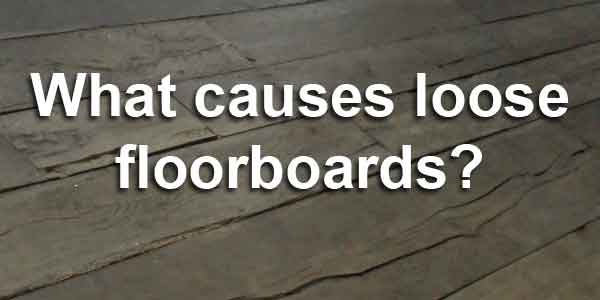Loose floorboards are pretty common, especially in older properties and there are several reasons this can happen. In most cases it will be due to general wear and tear, or poor fitting. However, in a small number of instances it can be the sign of a more serious issue.

There are really only 3 reasons that a floorboard will become lose. These are:
- The fixings (nails or screws) have been damaged or deteriorated over time.
- There has been damage to the timber, in either the floorboards or the joist below
- Or the floorboards have been fitted poorly.
In the vast majority of cases, one of these three will be the issue and in most cases, it will be an easy fix.
Generally, a loose floorboard is not dangerous. However, there is always the chance of it becoming a slight trip hazard. There is also the potential to damage the finished flooring above, such as carpets or vinyl flooring.
Plus, let’s be honest, a loose floorboard can be quite annoying. This is especially true if it creaks or makes any other noises underfoot.
How to access your loose floorboards
We have already mentioned the three main reasons your floorboards might be loose. So, to determine this for yourself, the best thing to do is take a look.
In order to do this, you will need to access the floorboards. So, in this article we will assume we are talking about standard timber floorboards under a carpet.
To access the boards, you will just need to lift the carpet back. To do this, you should pull the carpet away from the grippers at the edge of the room and potentially the door threshold. This is pretty easy, and you should be able to do this with your bare hands. Also, in most cases replacing the carpet is pretty easy too.
Checking the loose floorboards
Once you have access to the loose floorboard. You should first determine how it is fixed to the joists below. This is very simple, just look at heads of the fixings in the floorboard. Are they nails, or are they screws?
Screwed floorboards are usually easier to remove, as you can just use a screwdriver or a cordless drill. If the boards are nailed, you will need a crowbar and a hammer to get them up.
Next, you can see how loose the board is. For example, is it just loose in one place? Or can you completely remove the board.
If it is completely loose, but all your other boards are fixed securely, it has likely someone has removed the board previously, and not fixed it back correctly. This is usually to access something below the floorboards. Possibly a plumber or an electrician will have done this.
In this case, you will need to check for pipes and wires. Once you are confident you won’t hit anything, you can screw the board back in place. Screws are a better option than nails in my opinion, just because they get a better fixing. They are also easy to add and remove at a later date.
Another sign floorboards have been removed by a tradesman are cut boards. Often times they will cut the floorboards and just remove a small section. If you do see this, you have your answer, and you know why the board is loose.
Again, I just want to stress the point, that you should always double check for wires and pipes before you start screwing through floorboards.
Checking for damaged fixings or timber
If you have ruled out a poorly fitted board, you will need to look at any potential damage to the existing boards and fixings.
It is quite common for old boards to be fixed with old nails. Over the years, these can rust and deteriorate. If you can see obvious issues with the existing fixings, then a few well-placed screws will usually cure your loose floorboard.
Again, pipes and wires are always a potential issue, so you will need to be careful. Check where possible. If it is just one or two fixings required, you can add screws right next to the old nails.
The final issue you could face is damaged boards. This could be for several reasons. For example:
- Cracked or damaged when fitted, or even due to a defect in the timber that has caused a split or a crack.
- Damp or rotten timber. This is more serious, and you will need to remove and replace the floorboards
- In rarer cases, you could find evidence of wood burrowing insects such as woodworm.
In all of these cases, at the very minimum, you will want to replace the board. If the board is just old and damaged, but it doesn’t seem to be for any sinister reason, you can simply remove the old board and replace with a new floorboard.
Getting help from a specialist
If damp, rot, or insect infestation are present, you will need to investigate further. This will involve checking surrounding boards and joists for the same issue.
Obviously, any of these have the potential to cause major problems if left untreated. Therefore, it is usually advised to talk with a professional. Most good damp proofing companies will deal with all of the above issues.
You can easily find local damp proofing experts to help with this kind of problem by Clicking here.
Conclusion
As you can see, there are several reasons a floorboard could become loose. In the vast majority of instances, this will usually be quite innocent and easy to fix for the average DIY’er. With that said, there are times where more serious issues could be present. In this case, it is often better to err on the side of caution and speak with a professional.




